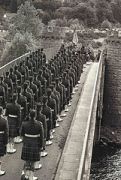1819 Tour of Scotland
Robert Southey was Poet Laureate in 1819 when he joined civil engineer Thomas Telford on a tour of Scotland. After a night stop in Rothes they journeyed a few miles on towards Craigellachie, below is his journal entry:-
It began to rain when we renewed our journey, but held up before we had advanced two miles, when we came upon Craig-Elachie
Bridge, one of Telford's works, and a noble work it is. The situation is very fine, under
the crag from which it takes its name, and of which a great part, to the height perhaps of 100 feet has been cut away in making a
road to it.
That road brings the traveller
by a short tour to the two short turrets
at the entrance of the bridge : on this side
they are merely ornamental, on the other
their weight is necessary for the abutment.
The bridge is of iron, beautifully light, in
a situation where the utility of lightness is
instantly perceived.
The span is 150 feet, the
rise 20 from the abutments, which are them-
selves 12 above the usual level of the stream.
The only defect, and a sad one it is, is that
the railing for the sake of paltry economy
is of the meanest possible form, and therefore
altogether out of character with the rest of
the iron work, that being beautiful from its
complexity and lightness. But this farthing-
wisdom must now appear in everything that
Government undertakes ; and thus the appear-
ance of this fine bridge has been sacrificed for
the sake of a saving, quite pityful in such a
work.

Did you Know?
The Craigellachie Bridge is one of only a few engineering projects in Scotland that has been recognised as a landmark of importance by both the American Society of Civil Engineers and the Institution of Civil Engineers – it is right up there with the Golden Gate Bridge in San Francisco.
It is the oldest surviving monumental cast iron bridge in Scotland and therefore one of the oldest in the British Isles.
The components of the bridge were cast as Plas Kynaston in North Wales and were transported to site along the Ellesmere Canal and Pontcyssylte Aqueduct, and then by sea to Speymouth where the components were finally brought to site by horse-drawn wagon.
During the 1962-63 work undertaken on the bridge, a specimen of the cast iron used by Telford was tested and found to be an especially high quality of cast iron, with an ultimate tensile strength of 194 N/mm2, around 50% greater than common cast iron.

The bridge was used on 14th September 1994 as the location for a meeting between the Queen's Own Highlanders (Seaforth and Camerons) and the Gordon Highlanders, prior to the units amalgamating into the Highlanders (Seaforth, Gordons and Camerons). The Gordon Highlanders approached from the Banffshire side of the bridge, while the Queen's Own Highlanders approached from the Moray side.
During the Great Flood of 1829 the bridge held despite the level of the water being a full fifteen and a half feet higher than it's normal level. Many other bridges and buildings were simply swept away in the flood.
Read how the flood affected Craigellachie Bridge Here »
The full text of Sir Thomas Dick Lauder of Fountainhall 7th Baronet, published book entitled "An Account of the Great Floods in Morayshire in 1829 in the Province of Moray and adjoining Districts" here »





